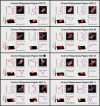Digital embryos: a novel technical approach to investigate perceptual categorization in pigeons (Columba livia) using machine learning
- PMID: 34989909
- PMCID: PMC9334434
- DOI: 10.1007/s10071-021-01594-1
Digital embryos: a novel technical approach to investigate perceptual categorization in pigeons (Columba livia) using machine learning
Abstract
Pigeons are classic model animals to study perceptual category learning. To achieve a deeper understanding of the cognitive mechanisms of categorization, a careful consideration of the employed stimulus material and a thorough analysis of the choice behavior is mandatory. In the present study, we combined the use of "virtual phylogenesis", an evolutionary algorithm to generate artificial yet naturalistic stimuli termed digital embryos and a machine learning approach on the pigeons' pecking responses to gain insight into the underlying categorization strategies of the animals. In a forced-choice procedure, pigeons learned to categorize these stimuli and transferred their knowledge successfully to novel exemplars. We used peck tracking to identify where on the stimulus the animals pecked and further investigated whether this behavior was indicative of the pigeon's choice. Going beyond the classical analysis of the binary choice, we were able to predict the presented stimulus class based on pecking location using a k-nearest neighbor classifier, indicating that pecks are related to features of interest. By analyzing error trials with this approach, we further identified potential strategies of the pigeons to discriminate between stimulus classes. These strategies remained stable during category transfer, but differed between individuals indicating that categorization learning is not limited to a single learning strategy.
Keywords: Avian; Common elements; Learning; Virtual phylogenesis; Visual system.
© 2022. The Author(s).
Figures








Similar articles
-
Pigeons' tracking of relevant attributes in categorization learning.J Exp Psychol Anim Learn Cogn. 2014 Apr;40(2):195-211. doi: 10.1037/xan0000022. J Exp Psychol Anim Learn Cogn. 2014. PMID: 24893218
-
Feature predictiveness and selective attention in pigeons' categorization learning.J Exp Psychol Anim Learn Cogn. 2017 Jul;43(3):231-242. doi: 10.1037/xan0000146. J Exp Psychol Anim Learn Cogn. 2017. PMID: 29120213 Free PMC article.
-
Testing analogical rule transfer in pigeons (Columba livia).Cognition. 2019 Feb;183:256-268. doi: 10.1016/j.cognition.2018.11.011. Epub 2018 Nov 30. Cognition. 2019. PMID: 30508704 Free PMC article.
-
The neuroscience of perceptual categorization in pigeons: A mechanistic hypothesis.Learn Behav. 2018 Sep;46(3):229-241. doi: 10.3758/s13420-018-0321-6. Learn Behav. 2018. PMID: 29532328 Review.
-
Modeling within-session dynamics of categorical and item-memory mechanisms in pigeons.Psychon Bull Rev. 2024 Aug;31(4):1420-1444. doi: 10.3758/s13423-023-02416-w. Epub 2023 Dec 7. Psychon Bull Rev. 2024. PMID: 38062316 Review.
Cited by
-
Visual categories and concepts in the avian brain.Anim Cogn. 2023 Jan;26(1):153-173. doi: 10.1007/s10071-022-01711-8. Epub 2022 Nov 10. Anim Cogn. 2023. PMID: 36352174 Free PMC article. Review.
-
Jackdaws form categorical prototypes based on experience with category exemplars.Brain Struct Funct. 2024 Apr;229(3):593-608. doi: 10.1007/s00429-023-02651-w. Epub 2023 Jun 1. Brain Struct Funct. 2024. PMID: 37261488 Free PMC article.
References
-
- Allan RW (1993) Control of pecking response topography by stimulus-reinforcer and response-reinforcer contingencies. In: H. P. Zeigler & H.-J. Bischof (Eds.), Vision, brain, and behavior in birds. The MIT Press, pp 285–300
-
- Aust U, Huber L. The role of item- and category-specific information in the discrimination of people versus nonpeople images by pigeons. Anim Learn Behav. 2001;29(2):107–119. doi: 10.3758/BF03192820. - DOI
MeSH terms
Grants and funding
LinkOut - more resources
Full Text Sources

